|
Traditionally used for cancer tumors, urinary
infections, and many other common ailments
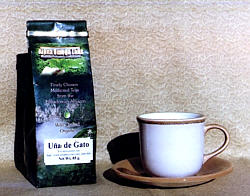
U�a de Gato
(Unicaria tormentosa)
[ pentacyclic alkaloid chemotype ]
Ground Root & Inner Bark
of U�a de Gato (Cat's Claw)
Code 320 -- Price: $12.95
Ground bark: 85 gr. (net wt)
Makes 4 Gallons of Tea
(Using 20 g. or ≅ 2/3 cup
to make one gallon)
U�a de Gato Capsules : Code 320C -- $16
(100 x 270 mg. veggie capsules)
Order Now
 Email
Email
 Summarized Description:
Cat's Claw Summarized Description:
Cat's Claw is one of our
traditionals.
The term "Cat's claw" is the common name for a
several plants,
so for the purposes of this page (and the representation of the product sold),
it is meant to refer to the root and inner back of
Peruvian U. tormentosa of the "pentacyclic variety,"
which is widely believed to be more medicinally active.
 Leslie Taylor claims that
"Cat's claw (U. tormentosa) has been used medicinally by
the Arguaruna, Ashaninka, Cashibo, Conibo, and Shipibo tribes
in Peru for at least 2,000 years" (1) -- a claim that Dr. James Duke
finds dubious (2). In my work work with shamans, herbalists,
and "curenderos" in both Ecuador and Peru, however, I can testify to its
importance. One widely respected shaman and herbalist in Provincia de Napo
who I became friends with in 2008 told me that few herbalists in his area
of the Ecuadorean Amazon do not employ this plant as one of their tools
for treating a wide variety of cancers.
 at's Claw
is powerful traditional from the Amazon,
used as a healing agent by the indigenous to treat a wide variety of health
conditions (see below). at's Claw
is powerful traditional from the Amazon,
used as a healing agent by the indigenous to treat a wide variety of health
conditions (see below).
Use & Protocol
 I. Capsule Usage --- Take two capsules,
morning and evening, unless otherwise advised by one of our practioners, or you own
health care provider. I. Capsule Usage --- Take two capsules,
morning and evening, unless otherwise advised by one of our practioners, or you own
health care provider.
 II. Tea Preparation --- if you can boil water, you
can make this product: Professional herbalists will
recognize this as a standard decoction. II. Tea Preparation --- if you can boil water, you
can make this product: Professional herbalists will
recognize this as a standard decoction.
- Add roughly 20 grams (about 1/4 of the bag of product) to
one gallon (about 4 liters) of purified water. Boil for 45 minutes
and then strain or filter out the remnants of the product.
- Drink 1/2 cup once daily at least one hour before a meal.
Warnings / Contraindications
 Despite a lack of in-depth studies,
Duke states, "I think it as innocuous as coffee," adding a reference
that "like other immunostimulants . . . should be avoided in such immune
disorders as HIV, MS, and tuberculosis." (3) Though widely used throughout
the tribes that prize this plant, Duke also notes that Cat's Claw has not
been shown to be safe for children and lactating or pregnant women. Despite a lack of in-depth studies,
Duke states, "I think it as innocuous as coffee," adding a reference
that "like other immunostimulants . . . should be avoided in such immune
disorders as HIV, MS, and tuberculosis." (3) Though widely used throughout
the tribes that prize this plant, Duke also notes that Cat's Claw has not
been shown to be safe for children and lactating or pregnant women.
 Also reported by Duke: "McGuffin et al. (1997)
cite Ken Jones who contraindicates
for patients receiving organ transplants or skin grafts, hemophiliacs
prescribed fresh blood plasma; simultaneous administration of certain
vaccines, hormone therapies, insulin, thymus extracts; not for children
under 3 years. Gruenwald et al. (2000) warn of precipitous drops in estradiol
and progesterone serum levels, following 8 weeks of use. Extracts prevent
estrogen from binding to estrogen receptors on breast cancer cells.
As of July 2007, the FDA Poisonous Plant Database listed two titles
alluding to toxicity of this species." (4) Also reported by Duke: "McGuffin et al. (1997)
cite Ken Jones who contraindicates
for patients receiving organ transplants or skin grafts, hemophiliacs
prescribed fresh blood plasma; simultaneous administration of certain
vaccines, hormone therapies, insulin, thymus extracts; not for children
under 3 years. Gruenwald et al. (2000) warn of precipitous drops in estradiol
and progesterone serum levels, following 8 weeks of use. Extracts prevent
estrogen from binding to estrogen receptors on breast cancer cells.
As of July 2007, the FDA Poisonous Plant Database listed two titles
alluding to toxicity of this species." (4)
 Taylor's only cited contraindication
is skin contact, which "may cause dermatitis and produce an allergic response." (5) Taylor's only cited contraindication
is skin contact, which "may cause dermatitis and produce an allergic response." (5)
Shelf-Life
 This product is dehydrated, so its
functional shelf-life is well in excess of two years. This product is dehydrated, so its
functional shelf-life is well in excess of two years.
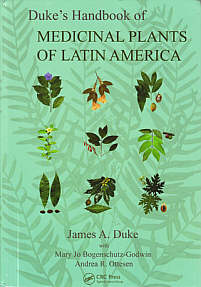
Medicinal Activities
 Further information for practitioners:
World-famous botanist Dr. James Duke attributes the following activities
to this plant (p. 728-729; see hardcopy cover at right),
drawn from the extant literature. (See his graduation for "level of
efficacy" on our amazon traditionals page;
followed by Duke's bibliographic abbreviations (in capital letters),
which we identify
on a separate page.) Further information for practitioners:
World-famous botanist Dr. James Duke attributes the following activities
to this plant (p. 728-729; see hardcopy cover at right),
drawn from the extant literature. (See his graduation for "level of
efficacy" on our amazon traditionals page;
followed by Duke's bibliographic abbreviations (in capital letters),
which we identify
on a separate page.)
- Analgesic (1; LYM);
- Antiaggregant (1; LYM; MCK; PH2; RAI);
- Antialzheimeran (1; MCK);
- Antiamyloidosis (1; MCK);
- Antiapoptotic (1; MCK);
- Antiarrhythmic (1; X12546715);
- Antiarthritic (2; X11950006);
- Anticoagulant (1; LYM);
- Antidepressant (1; LYM);
- Antidiabetic (f; MBC);
- Antidysenteric (1; LYM);
- Antiedemic (1; APA; HH3; LYM; PH2);
- Antifertility (1; RAI);
- AntiHIV (1; APA; MCK);
- Antihypertensive (1; PH2);
- Antiinflammatory (f1; APA; LYM; MCK; VAD);
- Antileukemic (1; LYM; PH2, RAI);
- Antimelanomic (1; APA; 60P);
- Antimutagenic (1; APA; HH3; LYM; RAI; 60P);
- Antioxidant (1; LYM; MCK; VAD; 60P);
- Antiprostaglandin (1; RDF3:5);
- Antiradicular (1; MCK; 60P);
- Antirheumatic (f1; MCK);
- Antirhinoviral (1; HH3);
- Antisarcomic (1; HH3; 60P);
- Antistomatitic (1; HH3);
- Antithrombic (1; PH2);
- Antitumor (1; APA; HH3; LYM);
- Antiulcer (f1; MBC; MCK);
- Antiviral (12; APA; HH3; LYM; RAI; 60P);
- Aphrodisiac (f; MBC);
- Apoptotic (1; PH2);
- Bactericide (1; APA);
- Calcium-Antagonist (1; PH2; X12546715);
- Contraceptive (f1; HH3; LYM; MBC; MPG; PH2; 60P);
- COX-2 Inhibitor (1; RDF3:5);
- Cyclooxygenase-Inhibitor (1; RDF3:5);
- Cytoprotective (1; MCK);
- Cytostatic (1; MPG; 60P);
- Depurative (f1; LYM; MCK, RAI);
- Detoxicant (1; LYM; RAI);
- Diuretic (1; RAI);
- Dopaminergic (1; FNF);
- Estrogen-Agonist (1; MCK);
- Febrifuge (1; HH3);
- Gastroprotective (1; MCK);
- Hypocholesterolemic (1; LYM; RAI);
- Hypotensive (1; RAI; X14668978);
- Immunostimulant (1; APA; HH3; LYM; SKY; VAD);
- Interleukinogenic (1; PH2);
- Leukocytogenic (1; LYM);
- 5-Lipoxygenase-Inhibitor (1; MCK);
- Mutagenic (1; ISSN:0250-7005);
- NF-kB Inhibitor (1; LYM);
- Phagocytotic (1; APA; HH3; 60P);
- TNF-Inhibitor (1; RAI);
- Tonic (f1; LYM);
- Vasodilator (1; RAI; X14668978);
- Vulnerary (1; LYM).
Indications
 Further information for practitioners:
Duke provides the following indications for this plant: Further information for practitioners:
Duke provides the following indications for this plant:
- Allergies (1; APA; HH3);
- Alzheimer's (f1; MCK; RAI);
- Amyloidosis (1; MCK);
- Anxiety (f; MCK);
- Arrhythmia (1; X12546715);
- Arthrosis (f12; APA; HH3; LYM; X11950006; 60P);
- Ascites (1; HH3);
- Asthenia (f1; RDF3:5);
- Asthma (f; APA; LYM; MBC; PH2; VAD);
- Bleeding (f; MCK);
- Borrelia (12; LYM);
- Cancer (f1; APA; HH3; MPG; PH2; RAI; 60P);
- Cancer, breast (1: ISSN:0250-7005);
- Candidiasis (f; APA);
- Cardiopathy (f1; RAI; X14668978);
- Childbirth (f: MCK);
- Cirrhosis (f; LYM; MBC; MPG);
- Debility (f; MCK);
- Depression (f; RAI);
- Dermatosis (f; HH3; LYM; MBC);
- Diabetes (f; VAD; 60P);
- Diverticulosis (f; RAI);
- Duodenosis (f; VAD);
- Dysentery (f1; LYM; RAI);
- Dysmenorrhea (f; MCK; PH2; VAD);
- Dyspepsia (f; APA);
- Edema (1; APA; HH3; LYM; SKY);
- Enterosis (f1; APA; RAI);
- Fever (f1; HH3; LYM; MCK);
- Flu (f; RAI);
- Gastrosis (f1; APA; DAV; HH3);
- Gonorrhea (f; RAI);
- Gout (1; RAI);
- Hemorrhoids (1; APA);
- Hepatosis (f; MPG);
- Herpes (f1; HH3; RAI);
- High Blood Pressure (1; X14668978);
- High Cholesterol (1; LYM; RAI);
- HIV (1; APA);
- IBS (1; RAI);
- Immune Dysfunction (1; APA; MPG; SKY);
- Impotence (f; MBC);
- Infection (1; HH3; MPG);
- Inflamation (f1; APA; LYM; MPG; RAI; SKY);
- Ischemia (1; X12546715);
- Leaky Gut (f1; RAI);
- Leukemia (f; RAI);
- Leukopenia (1; LYM; X12622460);
- Lyme (1; LYM);
- Lymphoma (1; RAI);
- Melanoma (1; APA);
- Metastasis (1; MBC);
- Myalgia (1; LYM);
- Nephrosis (f; MBC);
- Neuralgia (f; RAI);
- Neuroborreliosis (1; LYM);
- Neurodermatosis (f; HH3);
- Ostealgia (f; LYM; MCK);
- Osteoarthriti (f; VAD);
- Osteoporosis (12; MCK);
- Pain (f1; LYM; MBC);
- Parkinson's (1; MCK);
- Pneumonia (1; LYM);
- Prostatosis (1; APA; LYM; MBC);
- Rheumatism (f12; MBC; MPG; RAI; X11950006);
- Rhinovirus (1; HH3);
- Sarcoma (1; MPG);
- Shingles (f; RAI);
- Snake Bite (f; MBC);
- Sores (f; MBC);
- Stomatosis (1; HH3);
- Stroke (f; RAI);
- Swelling (1; HH3);
- Thrombosis (1; PH2);
- Ulcers (f1; APA; DAV; LYM; MCK; VAD);
- Urethrosis (f; MCK);
- VD (f; RAI);
- Viruses (f1; HH3; MPG; RAI);
- Wounds (f1; HH3; LYM; RAI);
- Yeast (f; APA).
Footnotes
- Taylor, Leslie, The Healing Power of Rainforest Herbs, Square One Publishers, 2005, p. 218
- Duke, James A., Medicinal Plants of Latin America, CRC Press, 2009, p. 727.
- Ibid., p. 729, citing Foster, S., Herbs for Your Health -- A Handy Guide for Knowing and Using 50 Common Herbs, Interweave
Press, Loveland, CO, 1996.
- Ibid., citing McGuffin, M., Hobbs, C., Upton, R. and Goldberg, A. (Eds.), American Herbal Products Association's
Botanical Safety Handbook, CRC Press, Boca Raton, FL, 1997, p. 231; and Gruenwald, J. et al. PDR for Herbal Medicines,
Ed. 2, Medical Economics Company, Inc., Montvale, NJ. 2000, p. 858.
- Taylor, p. 216.
- See : Enthnopharmacology (1999)
Citing: Kingberg, L., 1980. Diccionario Asha�ninka, Instituto linguistico de verano, Pucallpa, Peru
� - Duke, p. 729.
- Ibid.
|
 To U.S. Users: To U.S. Users: This product
have not been evaluated by the U.S. Food & Drug Administration.
It is not intended to diagnose, treat, cure, or prevent any disease.
|
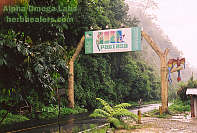 Sourcing From
Sourcing From
The Amazon
 All the materials used to
make our Ajo T� are wild-crafted and harvested
from deep in the the provinces of Pastaza and Moreno Santiago, near the
Peruvian border. There are no cultivated varieties.
Click photo to enlarge.
Dosages &
Ethnobotanical
Usage
 Duke provides a "food pharmacy
potential" score for this plant of, "FNFF=!" ("Survival food . . .
questionable"). This makes sense as no one I have encountered in
South America uses it as a food source. Kingberg notes that
Cat's Claw is not even found in any register of Peruvian healing
plants (despite its many, obvious medicinal properties),
as it is regarded as a "religious plant" -- despite
not being used as an entheogenic. (6)
 Dosages and protocols vary
widely according to indication and culture. Duke notes:
"Bark decoction used to wash deep wounds, 2X/day (MCK). 20g root bark / liter of water (HH3);
one gram root / cup tea, 3X/day (SKY); 30 grams powdered root / 800 ml. water
simmered to 500 ml. (PH2); one tsp. decoction (SF); one cup decoction, 2X/day (RAI);
2-4 ml. tincture, 2X / day (RAI); one to two ml. tincture 1-2x/day (SKY);
1-2 (500 mg.) bark capsules, 3x/day (NH); 2 (505mg.) StX capsules/day (NH);
20-60 mg. StX. Fernando Cabieses seems to believe the folk conceptive
dosage; boiling 11-13 pounds root until it is reduced to one cup (pretty tricky)." (7)
 [ We don't recommending using this plant as
a contraceptive. Cow's Foot is far
more commonly used for this purpose.]
 Here are other ethnobotanical uses cited by Duke (8):
- Ashaninka use for arthritis, bone ache, cancer, urinary inflammation, and to
prevent conception and diseases in general (MCK; RAI).
- Colombians take for dysentery and gonorrhea (RAI).
- Peruvians boil 2 tbsp. bark in 1.5 liter water, taking 0.5 glass, 3X/day before meals (MPG).
- Peruvians suggest the herb for abscesses, arthritis, asthma, bleeding, blood disorders,
bone ache, cancer, cirrhosis, dermatosis, diabetes, diarrhea, dysentery, dysmenorrhea,
enterosis, fever, gastrosis, gonorrhea, herpes, HIV, immunodepression, inflammation,
nephrosis, prostatitis, rheumatism, shingles, tumors, ulcers, urogenitosis, and wounds (RAI).
- Surinamese take for dysentery, enterosis, and wounds (RAI).
How U�a de Gato
Is Sold Locally
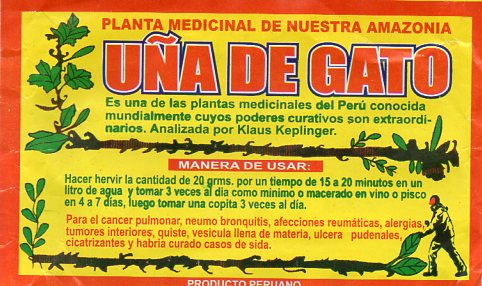
 U�a de Gato is revered for its
its medicinal properties throughout Ecuador and Peru. The image
above ( enlarge)
shows a package label as the product may be found throughout both
countries.
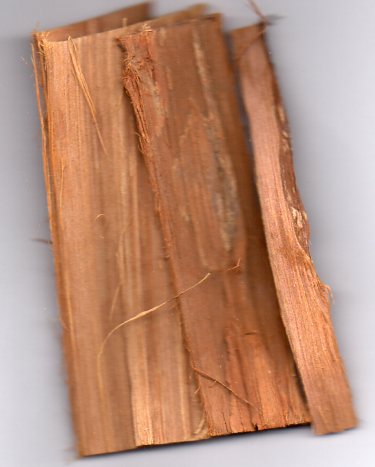
 A translation of the label
reads as follows:
 "Medicinal Plant from Our Amazon: U�A DE GATO.
 "It is one of the medicinal plants of Peru known
worldwide whose curative powers are extraordinary. [Analyzed by Klaus Keplinger]."
 Following user instructions, the common
indications for its use are given: "For lung cancer, pneumococcal bronchitis,
rheumatism, allergies, internal tumors, cyst, impacted gallbladder, ulcers,
scars, and has been known to cure cases of AIDS. [Product of Peru]
|


 Also reported by Duke: "McGuffin et al. (1997)
cite Ken Jones who contraindicates
for patients receiving organ transplants or skin grafts, hemophiliacs
prescribed fresh blood plasma; simultaneous administration of certain
vaccines, hormone therapies, insulin, thymus extracts; not for children
under 3 years. Gruenwald et al. (2000) warn of precipitous drops in estradiol
and progesterone serum levels, following 8 weeks of use. Extracts prevent
estrogen from binding to estrogen receptors on breast cancer cells.
As of July 2007, the FDA Poisonous Plant Database listed two titles
alluding to toxicity of this species." (4)
Also reported by Duke: "McGuffin et al. (1997)
cite Ken Jones who contraindicates
for patients receiving organ transplants or skin grafts, hemophiliacs
prescribed fresh blood plasma; simultaneous administration of certain
vaccines, hormone therapies, insulin, thymus extracts; not for children
under 3 years. Gruenwald et al. (2000) warn of precipitous drops in estradiol
and progesterone serum levels, following 8 weeks of use. Extracts prevent
estrogen from binding to estrogen receptors on breast cancer cells.
As of July 2007, the FDA Poisonous Plant Database listed two titles
alluding to toxicity of this species." (4)


